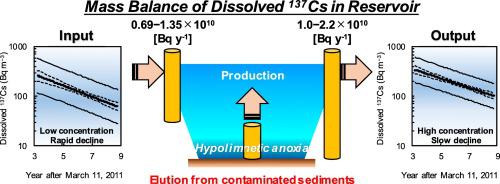Science of the Total Environment ( IF 8.2 ) Pub Date : 2020-07-01 , DOI: 10.1016/j.scitotenv.2020.140668 Hironori Funaki 1 , Kazuyuki Sakuma 1 , Takahiro Nakanishi 1 , Kazuya Yoshimura 1 , Estiner Walusungu Katengeza 2

|
Because of their large mobility and high bioavailability, it is necessary to elucidate the origins and dynamics of dissolved radionuclides in river and reservoir systems to assess the transfer of those radionuclides from water to crops and aquatic organisms. Elution from contaminated reservoir sediments, a potential source of dissolved radionuclides, presents a long-term concern, particularly for long-lived radionuclides. In this study, we systematically investigated caesium-137 (137Cs) concentrations using a time-series suite of input and output water samples collected from 2014 to 2019 from the Ogaki Dam Reservoir, which has a catchment with a high 137Cs inventory due to the Fukushima Dai-ichi Nuclear Power Plant accident. The results of our study showed that dissolved 137Cs concentration was significantly higher in the output water than that in the main input water, and that the effective ecological half-life of dissolved 137Cs in the output water was longer than in the main input water. We quantitatively evaluated the mass balance of dissolved 137Cs in the reservoir to elucidate how much dissolved 137Cs from the rivers and production from reservoir sediments contribute to 137Cs in the reservoir output. The annual output of dissolved 137Cs was significantly higher than the total input of dissolved 137Cs, with approximately 32%–40% of the dissolved 137Cs in the output water presumably being produced from reservoir sediments. Consequently, the estimated dissolved 137Cs fluxes from reservoir sediments to overlying water were 0.57–1.3 × 104 Bq m−2 y−1. This implies that approximately 0.04%–0.09% of 137Cs accumulated in the sediments was released through elution to the overlying water each year. Reservoir sediments containing high 137Cs levels may thus become even more important as sources of bioavailable dissolved 137Cs in the future.
中文翻译:

水库沉积物是水系统中溶解的放射性铯的长期来源;日本福岛人工水库的质量平衡案例研究。
由于它们的大迁移率和高生物利用度,有必要阐明河流和水库系统中溶解的放射性核素的起源和动态,以评估这些放射性核素从水到作物和水生生物的转移。从受污染的水库沉积物(一种潜在的溶解的放射性核素)中洗脱出来是一个长期的问题,特别是对于长寿命的放射性核素。在这项研究中,我们使用了2014年至2019年从大垣水库蓄水的137个Cs存量高的流域,使用2014年至2019年收集的输入和输出水样的时间序列套件,系统地研究了137 Cs的浓度。福岛第一核电站事故。我们的研究结果表明,溶解输出水中的137 Cs浓度显着高于主输入水中的137 Cs浓度,并且输出水中溶解的137 Cs的有效生态半衰期比主输入水中的更长。我们定量评估了水库中溶解的137 Cs的质量平衡,以阐明河流中溶解的137 Cs和水库沉积物的产量对水库产出中137 Cs的贡献。溶解的年产量137个Cs的比溶解的总输入显著更高137个CS,与约32%-40溶解的%137产出水中的Cs大概是由储层沉积物产生的。因此,估计从储层沉积物到上覆水的溶解137 Cs通量为0.57–1.3×10 4 Bq m -2 y -1。这意味着每年沉积物中沉积的137 Cs中约有0.04%–0.09%是通过淋洗释放到上覆水中的。因此,作为未来生物可利用的137 Cs的来源,含137 Cs高的储层沉积物可能变得更加重要。











































 京公网安备 11010802027423号
京公网安备 11010802027423号